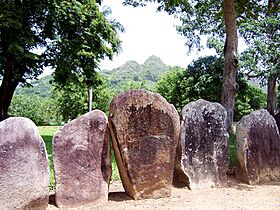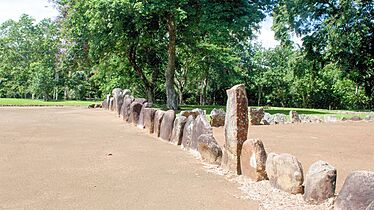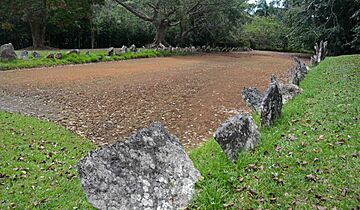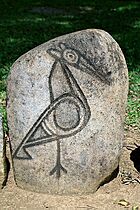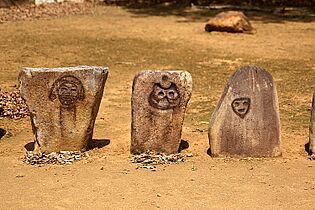Caguana Ceremonial Ball Courts Site facts for kids
|
Caguana Ceremonial Ball Courts Site
|
|
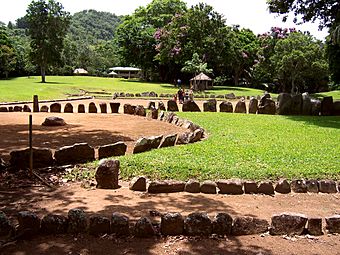
Taíno ball courts at Caguana Site
|
|
| Location | Highway 111, Km 12.3 Utuado,Puerto Rico |
|---|---|
| Area | 7 acres (2.8 ha) |
| Built | Around 1270 AD |
| MPS | Ball Court/Plaza Sites of Puerto Rico and the U.S. Virgin Islands |
| NRHP reference No. | 92001671 |
Quick facts for kids Significant dates |
|
| Added to NRHP | December 17, 1992 |
| Designated NHL | November 4, 1993 |
The Caguana Ceremonial Ball Courts Site, also known as the Caguana Site, is a very old and important place in Puerto Rico. It is an archaeological site, which means it's a place where people study the past by digging up old things. This site is special because it has well-preserved ceremonial ball courts and large stones with carvings called petroglyphs.
These courts were built by the Taíno people around 1270 AD, which means they are over 700 years old! The Taíno were the native people who lived in the West Indies before Europeans arrived. The Caguana Site is considered one of the biggest and most important Taíno sites in this region.
Contents
What You Can See at Caguana
About 13 ball courts and open areas, called bateyes by the Taíno, have been found and fixed up to look like they did long ago. You can see large stones, called monoliths, with amazing carvings made by the Taíno. Some of these stones are very heavy, weighing more than a ton! They were probably brought from the nearby Tanamá River.
Amazing Stone Carvings
The Caguana Site has the largest collection of petroglyphs in the Antilles, which are islands in the Caribbean. Most of these carvings are on the stone monoliths that form the ball courts. Some famous carvings include a bird that looks like a heron and a figure called atabeyra, also known as the "Caguana woman." This carving is thought to represent Atabey, a Taíno goddess of fertility.
Stars and Ancient Calendars
The way the ball courts are set up at Caguana suggests that the Taíno people used them to watch the sky. The site might have been a place to observe and even predict events in space, like how planets and stars move. Many of the petroglyphs show things from the sky, like the moon, stars, and planets. Even though Caguana is not a World Heritage Site, its features related to watching the stars are well-known and recognized by UNESCO.
History of the Site
Local people used to call this area Corrales de los Indios, which means "Indian corrals," because the ball courts looked like corrals for animals.
Early Discoveries and Studies
The first time someone officially explored and mapped the site was in 1914. This was done by an American expert named John Alden Mason. Since the 1930s, people have been continuously studying the site. Archaeologists from Yale University, like Irving Rouse, worked here. Later, the Institute of Puerto Rican Culture (ICP) and Dr. Ricardo Alegría took over the studies.
Protecting and Opening the Park
The ICP bought the site in 1965. They worked hard to restore the ancient structures and build things for visitors. The park and a small museum first opened to the public in 1965.
The museum was closed for a few years but reopened in June of 2024. It now has more than 200 ancient items on display. In 2024, the Institute of Puerto Rican Culture also launched a digital version of the museum, so people can explore it online!
Protecting Caguana Today
The Institute of Puerto Rican Culture still manages the site. They call it the Caguana Indigenous Ceremonial Center (or Parque Ceremonial Indígena de Caguana in Spanish).
The National Park Service in the United States has recognized Caguana as a very important historical place. It was added to the National Register of Historic Places in 1992 and named a National Historic Landmark in 1993. It was also listed on the Puerto Rico Register of Historic Sites and Zones in 2001.
What Else to See at the Park
The park also has a small museum where you can see Taíno artifacts and learn more about their history. There's also a small botanical garden. This garden shows some of the plants the Taíno people grew for food, like sweet potatoes, cassava, corn, and yautía. You can also see trees that the Taíno used to build their homes, called bohíos, such as mahogany and ceiba trees.
Gallery
Scenes at Caguana Ceremonial Ball Courts Site:
See also
 In Spanish: Centro ceremonial indígena de Caguana para niños
In Spanish: Centro ceremonial indígena de Caguana para niños



